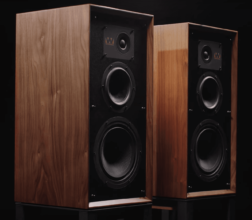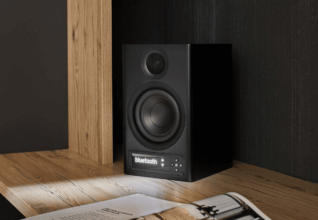Elac Adante As-61 Review – Small Package, Big Sound
By Thomas J. Norton
GERMANY-BASED ELAC known in the 1960s and 1970s for its automatic (Miracord) turntables. The company disappeared from North America in the ensuing decades while transitioning into a major European loudspeaker brand. A few years ago, it decided that the time was right to return to the U.S. market. To produce new designs for that move they lured veteran speaker designer Andrew Jones away from his extended gig at TAD/Pioneer. The ELAC Debut line (now in its second generation) came first and seriously shook up the budget speaker sector. That was followed not long after by the pricier, but hardly pricey, Uni-Fi series. (Reviews of both the Elac Debut and Uni-Fi series speakers in 5.1 configurations can be found at soundandvision.com.)
It was inevitable that ELAC would climb higher up the price ladder, and the first result of that process is the new Adante range. But the climb was only a few rungs. While the Adantes will be considered expensive by K-Mart shoppers, in the audiophile world their prices are highly competitive.
The AS-61 standmount model is the least expensive speaker in the Adante range, which also features the AF-61 tower and AC-61 center-channel speakers. Its featured attraction is a coincident midrange/tweeter. Andrew Jones has used this type of driver in all but the least expensive of his designs, including his pre-ELAC work. In a coincident driver, the tweeter is located at the apex of the midrange cone, which restricts dispersion at the low end of its range to better match the limited top-end dispersion of the driver covering the midrange. In the AS-61, the tweeter is a soft dome (protected by a web-like grille), but the other drivers use aluminum cones.
The AS-61 combines this coincident midrange/tweeter with a larger woofer. But the “woofer” you see from the outside is actually a passive radiator. The active woofer is a 6.5-inch design mounted in a sealed box located entirely inside the cabinet. This driver fires into a second chamber toward the back of that 8-inch passive radiator, which in turn passes the bass to the outside.
A passive radiator acts like a port, but without port noise or resonances. The woofer configuration used here also acts as a mechanical low-pass filter, passively rolling off the top end of the woofer’s response above 200 Hz. Although a 200-Hz crossover can be useful, it’s rarely seen in three-way designs since the low-pass leg typically requires a large, heavy, and expensive inductor. The AS-61’s midrange/ tweeter crossover point is 2,000 Hz.
The AS-61 is available in gloss black, gloss white, or matte rosewood finishes. It’s solid and well-braced, and fitted with two sets of excellent-quality, biwire-able binding posts. I used single wiring for this review.
SETUP
I initially set up the AS-61s about 44 inches from the closest wall behind them (measured from the center of the front baffle), roughly 9 feet apart, and 11 feet from my listening position. The system driving the speakers consisted of a Marantz AV8802A pre-pro (with its room EQ,
The AS-61 features a 6.5-inch woofer contained within a sealed box inside the speaker’s cabinet. This passes bass on through an 8-inch passive radiator.
tone controls, and other internal processing bypassed), a 5-channel Proceed Amp 5, and a Marantz UD7007 universal disc player. The cables used were Kimber AGDL (digital link from player to pre-pro), vintage Cardas Hexlink (pre-pro to power amp), and AudioQuest Rocket 88 (speaker). All music sources were from CD. The Adantes come with easily removable grilles secured by magnets, but I left them off for all of my tests and listening.
LISTENING
The sound I heard from the AS-61s impressed me immediately. With good source material their top end was neutral—neither rounded off nor overcooked. Sibilants were clearly defined but unexaggerated (or at least as natural as close- miked vocalists can be). Lightly brushed cymbals, delicate finger sounds on guitars, the sheen of stringed instruments, and a singer’s preparatory breath intake at the beginning of a vocal track were all beautifully captured. The imaging was solid, and the sense of depth (when present in the recording) proved very satisfying.
The Adantes excelled on voices, both male and female, pop, and classical. Leo Kottke’s album My Father’s Face has long been one of my favorite reference discs for how clearly it shows off Kottke’s crisp guitar playing and distinctive voice. The latter isn’t his strong suit, but I’d be surprised to ever hear it sound better than it did on the AS-61s.
The balance there, and with other vocalists including Nils Lofgren, Holly Cole, The King’s Singers, Sinne Eeg (if you like great jazz vocals, check out this Danish star’s recordings), Jose Carreras, and Leontyne Price, was superb.
There was only one performance area where the AS-61 disappointed me: bass extension. But that was in my room. My open-concept listening space is huge, and this isn’t the first time I’ve experienced less-than-deep, solid bass with a pair of speakers under review, including ones far more expensive than the ELACs. But it’s also true that others, including the similarly priced Monitor Audio Silver 10s, can produce a much more satisfying
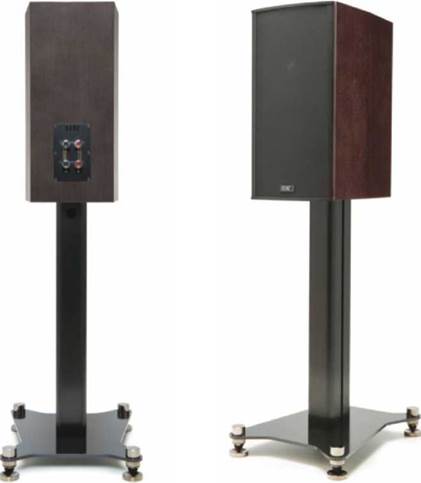
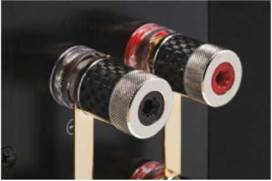
sense of weight in the low end than the AS-61s—in the same speaker and listener positions. (To be fair, the Silver 10s have two 8-inch woofers and a larger cabinet.)
Despite its low-end limits, the AS-61’s bass was tight and boom-free, so there was promise there. It’s no secret that the room itself, and where speakers and the listeners are positioned in the room, are just as important to the bass response you hear as the speakers themselves. My close measurements on the speaker taken near the 8-inch passive bass radiator using the Omnimic measurement system (not a laboratory-grade instrument, but useful and sufficient to the task here) showed that without any help from the room the AS-61 falls off
At a Glance
+ Detailed, clean highs
+ Superb vocal reproduction
+ Bloat-free bass
- Relatively low sensitivity
- Limited bass extension
test report
steeply below 50 Hz and its -6dB point is just over 40 Hz. The room can usually be counted on to offer at least some gain in the low bass, though that depends on the room’s size, configuration, and any openings to adjoining spaces. In a space as big and open as mine, the benefit is limited.
It was no surprise, then, that when I moved the speakers a foot closer to the wall behind them and a foot closer together (and the listening seat forward by roughly the same distance), I got better and sometimes even surprising results. The bass tightness remained, but it was now enhanced by a rewarding increase in bottom-end punch.
Below roughly 45 Hz, there was still little useful response. But there’s a solution for that, one strongly recommended for any standmount or bookshelf speaker, particularly in a big room: a subwoofer.
ELAC sent us its Adante SUB3070 subwoofer, a relatively compact 77-pounder equipped with two 12-inch, aluminum-cone drivers and a 1,200-watt (maximum) BASH amplifier in a sealed cabinet. A first sample proved faulty (a likely victim, perhaps, of an early production run), but a replacement for the defective sample worked beautifully.
The SUB3070 has a setup feature designed to minimize your room’s effect on the sub’s response. You first download ELAC’s Sub Control app and link the phone with the sub via Bluetooth. You then hold the phone as close to the woofer as possible and engage the app. This generates a low frequency sweep tone in the sub, which at close distance should result in a near anechoic measurement. You next take a similar measurement at the listening position.
The software in the sub then calculates a correction curve that’s applied to the subwoofer. Any errors in your cell phone’s microphone appear in both measurements so the app can compensate for them. It’s all very slick, and no measurement devices apart from your phone are needed. The main shortcoming is that it only optimizes for one position and can’t average readings for multiple seats.
The Sub Control app also provides full remote control for all of the important setup functions, including level and phase, plus four optional, preset tweaks to the corrected response (Normal, Music, Cinema, Night—I used Normal throughout) and eight separate bands of parametric equalization for additional fine tuning. I found this parametric EQ extremely useful, but
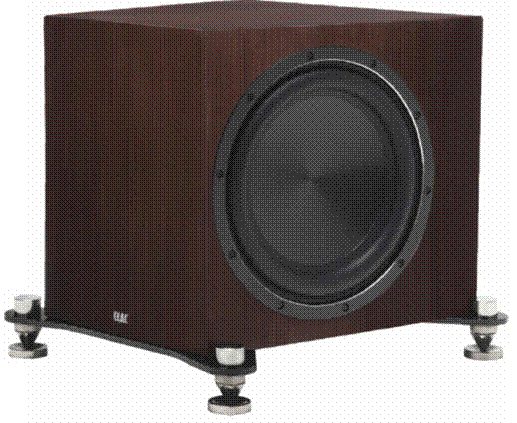
to employ it effectively you’ll need some sort of external measurement device, such as the above- mentioned Omnimic system from Parts Express that I use for in-room measurements.
After optimizing the sub’s response with the app, the results were exceptional. I threw all of my favorite music selections at it, including pounding drums, deep organ passages, and growling synth bass. Together with the AS-61s, the SUB3070 never left me wanting for more. No small, single sub will fully energize a room as big as mine (by “energize” I mean roll down your socks and turn your belly to jelly). But I heard and felt everything I needed to hear, and then some. The soundtrack from Blade Runner 2049, as played back on an almost full Adante system consisting of the AS-61s, the equally superb AC-61 center, the SUB3070, and, as non-ELAC outliers, Revel Concerta bi-pole surrounds, was a visceral experience. Nothing fazed
RATING
Subwoofer
PERFORMANCE 4.5/5
FEATURES 5/5
BUILD QUALITY 5/5
VALUE 4/5
Elac’s Sub Control app connects via Bluetooth and lets you tweak all features on the SUB3070.
Specs
ADANTE AS-61 6.5 in aluminum cone woofer, 5.25 in aluminum cone midrange, 1 in soft dome concentric tweeter; 9.6 x 19.06 x 15.81 in (WxHxD); 35.3 lb
SUB3070: 12 in aluminum cone (2); 1,200 watts BASH; sealed; line-level (2 x RCA, 2 x XLR), speaker level (2); Ethernet, USB; 20.39 x 1713 x 18.75 in (WXHXD); 77 lb
this setup. Even when played at levels I would never use for casual guests, and rarely even for myself (or visiting audio nuts), I didn’t hear a hint of strain or harshness.
CONCLUSIONS
I’ve said plenty here about the AS-61’s bass in my rather large listening space. In the speaker and listening positions that best serve both my two-channel music and home theater needs, the AS-61’s bass was tight and well-defined, but lean. But when I moved it closer to the wall behind it, and also moved the listening position forward, everything was in better balance. The bass wasn’t world-beating, but it still should make two-channel music listeners extremely happy.
With the pair of AS-61s in their original positions. supported by a good subwoofer, the situation completely changed. The Adante’s clear, rich midrange and natural high frequency sparkle continued, but was now fully supported to below 30 Hz. With the Adante SUB3070 subwoofer providing the low- frequency grunt needed for my room, I heard a system that could easily challenge far pricier speakers. Used this way (or without a sub for music in medium-sized spaces, up to perhaps 3,000 cubic feet), the ELAC Adante AS-61 earns an enthusiastic Top Pick.
The Adante AS-61’s soft-dome tweeter is protected by a web-like grille. The speaker’s other drivers use aluminum cones.
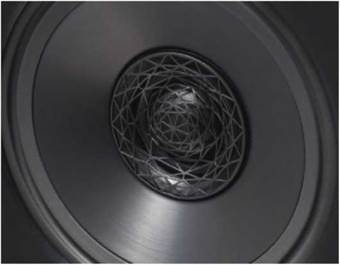
The Verdict
Elac’s step-up AS-61 standmounter gets most everything right. Combined with the company’s well-matched SUB3070 subwoofer, it makes for a highly appealing, high- performance speaker package





